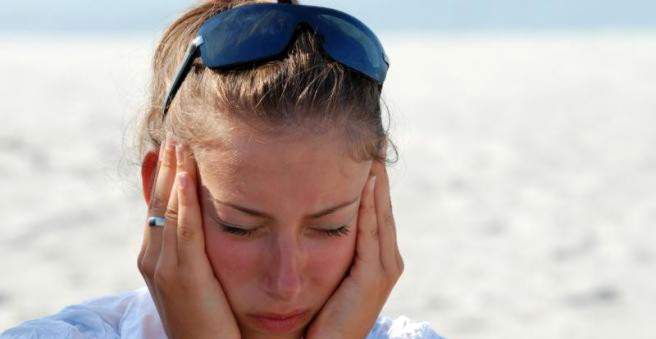Typical sunstroke symptoms include headache, vomiting nausea, fever, and a reddened head. In addition to these classic ailments, other signs of sunstroke may also appear. Thus, disorders of consciousness and seizures may be the expression of a severe sunstroke. Treating the sunstroke symptoms in good time can often alleviate and shorten the course of the disease. Read everything important here.

How do the sunstroke symptoms develop?
The typical symptoms of sunstroke are according to the current state of knowledge result of irritation of the meninges by the heat rays (infrared rays) of the sun The irritation and the resulting slight inflammation of the meninges can also affect the brain itself and thus lead to numerous complaints.
Sunstroke signs are usually delayed
The treacherous thing about sunstroke is that most of the typical signs are noticeable only after hours in the sun. The affected people notice them only when it is already too late. Typically, patients complain of the following symptoms:
- a headache
- Nausea and vomiting
- occasionally mild fever
- bright red, hot head
- unrest
- Fatigue and weakness
- Dizziness symptoms
Sunstroke symptoms in severe sunstroke
If the sunstroke is very pronounced, additional symptoms of sunstroke can be added to the classic symptoms. They are explained by a pronounced irritation of the meninges and sometimes of the brain tissue itself, which can lead to impairment of brain function. The reason for this is an increased pressure on the brain, which is trapped by an edema in the skull. In severe sunstroke the following symptoms may occur:
- Neck stiffness and pain in movements of the cervical spine increased pulse rate
- Dysregulation from confusion or dizziness to coma
- Seizures (epileptic seizures) (a rare sunstroke sign)
Sunstroke signs in small children
Infants and young children are particularly likely to be affected by a sunstroke due to the lighter head hair and thinner skull bones. For young children who can not speak yet, the typical signs of sunstroke are usually harder to recognize. Parents should therefore become aware of unusual behavior of their child. In infants, for example, these include shrill cries or the refusal to eat. In addition, the parents can feel with their backs whether the child’s head is overheated.
Are they really sunstroke symptoms?
In a sunstroke symptoms occur, which can also occur in other diseases. Therefore, the doctor may not make the diagnosis of sun-stroke prematurely, but must rule out other causes of the symptoms. Often a sunstroke is accompanied by a slight inflammation of the meninges, so that symptoms similar to a bacterial or viral encephalitis (meningitis) can occur. Especially the bacterial meningitis is a dangerous disease that can be life-threatening within a few hours. Typically, however, bacterial meningitis is associated with high fever, as opposed to a sunstroke.
Other syndromes may resemble a sunstroke. This includes:
- Heat stroke – a life-threatening combination of dehydration and overheating
- Stroke: a broken blood supply to parts of the brain.
- Lyme disease and TBE – two tick-borne diseases that can affect meninges and brain.
Who the classic Sunstroke symptoms knows, can react early and thus at least favorably influence the course.